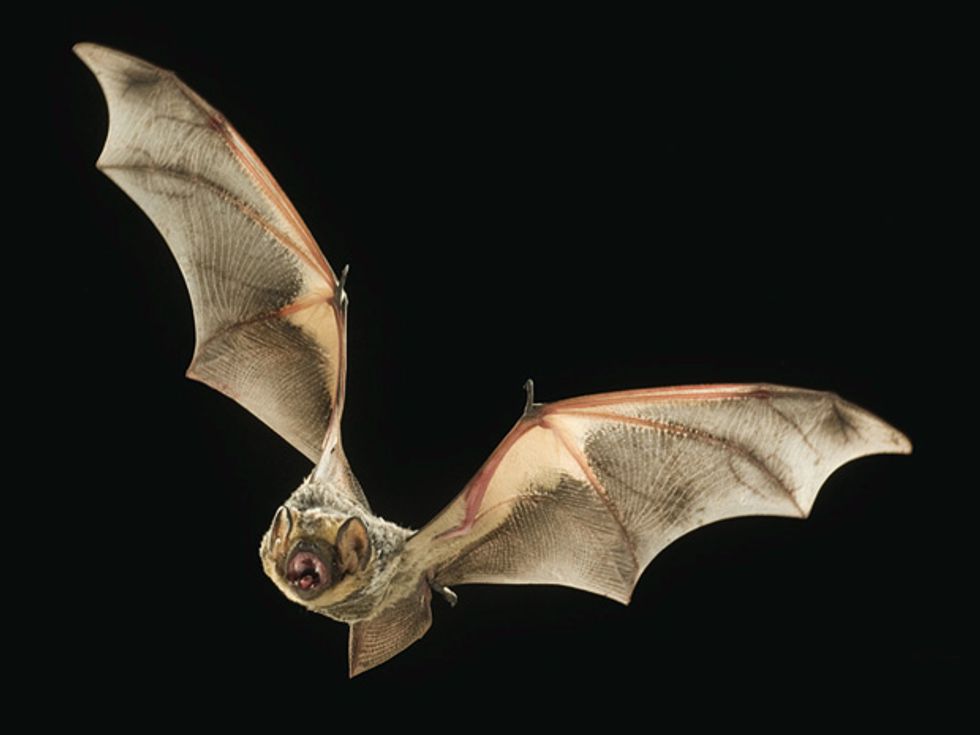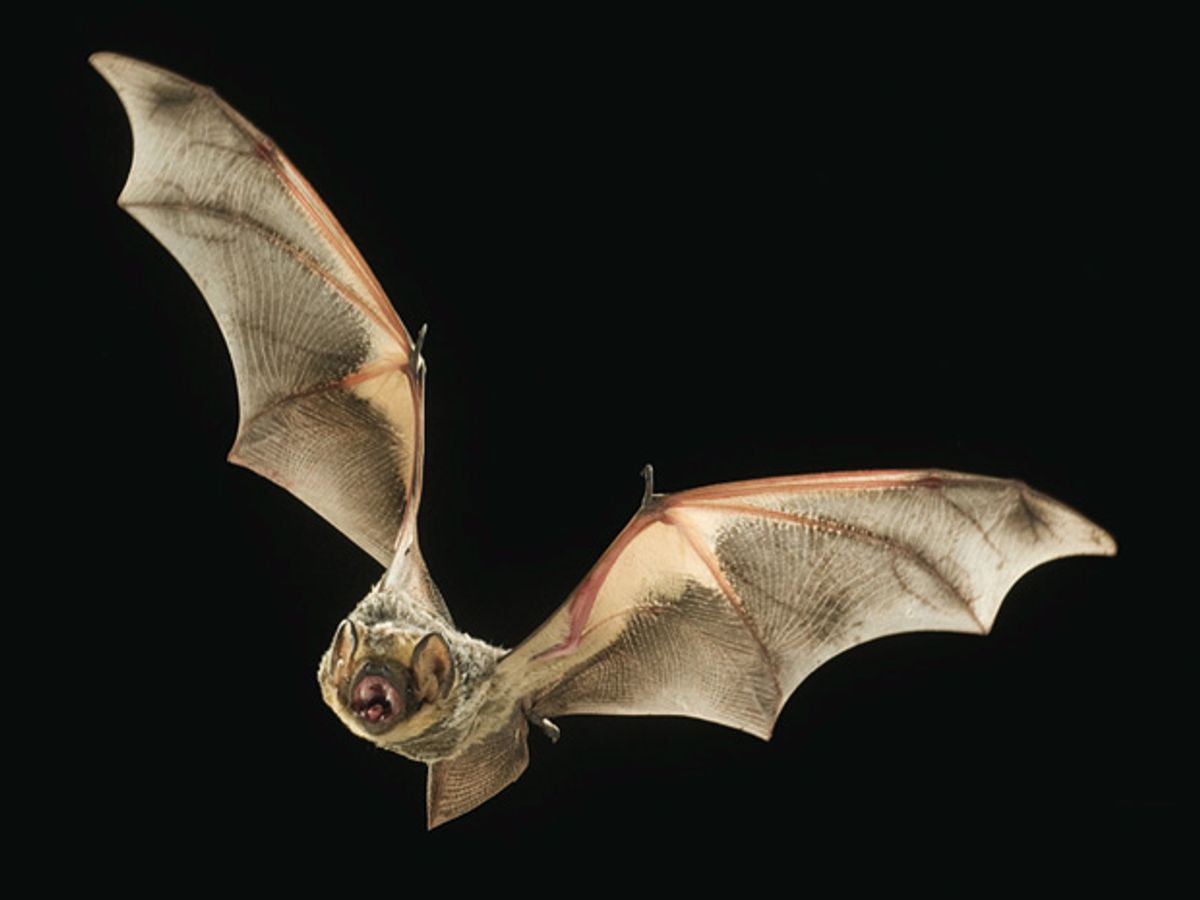
Fact one: Wind energy is booming around the world. Fact two: Wind turbines kill lots of bats. Fact three: Bats are worth billions to North American agriculture. Conclusion? Wind power has a bat problem. And with the Global Wind Energy Council predicting that worldwide wind capacity will double by 2016, the problem will only get worse. At a handful of U.S. sites, such concerns have already led planned wind facilities to be scaled back or put on hold.
This summer, engineers and bat biologists are coming together at a wind farm in Wisconsin to field-test a potential fix. They’ll attach ultrasonic microphones to four or five turbine nacelles to record the high-pitched squeaks and clicks bats emit for navigating and locating prey.
Based on the data collected there and at 40 other wind installations, software developers will create a predictive model that also factors in meteorological information like wind speed, temperature, and precipitation. The model will yield a probability score that indicates the risk to bats at the site at any given time. When the risk is high—meaning there are likely many bats present—the utility operator will be able to shut down the turbines and then bring them back up when the risk is low.
“This project is really focused on trying to reduce bat mortality at wind farms while at the same times maximizing electricity production,” says John Goodrich-Mahoney, a senior project manager at the Electric Power Research Institute (EPRI), the sponsor of the field test, which runs through next year. “How do you balance those two needs?”
Without question, he notes, these are bad times for bats. A fungal infection known as white-nose syndrome has killed at least 6 million bats in North America since it was discovered six years ago; some species, such as the Indiana bat and the gray bat, may go extinct as a result. The economic impact of losing so many insect-eating animals is staggering: A study published in Science last year estimated that bat deaths could lead to annual agricultural losses in North America of more than US $3.7 billion.
The devastating disease has in turn sharpened public attention on other threats to bats, including wind farms, says Susan Schumacher, a biologist with We Energies, the Wisconsin utility that will deploy the bat-detection system at its 88-turbine Blue Sky Green Field Wind Energy Center. Located on farmland in Fond du Lac County, the facility opened in 2008. We Energies conducted a bat mortality study there in 2008 and 2009 that estimated about 3500 bats were killed each year, says Schumacher. “We wanted to go the extra step and see if we could also reduce fatalities.” The system, called Remote Bat Acoustic Technology, or ReBAT, was developed by a Gainesville, Fla., subsidiary of Normandeau Associates. In addition to analyzing the recordings in real time, it will also identify species by their calls, so that if an endangered or threatened species is present, the utility can take extra precautions.
To the layperson, it may seem odd that a bat, with its exquisitely precise echolocation, would fly into something as large and slow-moving as a turbine blade. But Crissy Sutter, a bat biologist with Normandeau, points out that the ultrasonic frequencies bats use—typically between 15 and 150 kilohertz—travel only a few tens of meters before attenuating in air. “So as the bat is flying toward the rotor, it’s sending out calls at 20 meters, 10 meters, 5 meters, and it’s getting responses of ‘empty space,’ ‘empty space,’ ‘empty space,’ ” she explains. “There’s no hard target for that ultrasound wave to bounce back from.” Bats rarely collide with cellphone towers, which are fixed, Sutter adds.
Wind energy’s risk to bats came to light in 2003, when biologists searching for dead birds at a wind farm in West Virginia noticed hundreds of dead bats.[PDF] They concluded that 1400 to 4000 bats were being killed there each year. Since then, dozens of studies throughout North America and Europe have confirmed and refined the findings. For example, mortality rates tend to be higher at ridge-top installations than at flatland sites, and they peak during the spring and autumn when migratory bats are on the move. Most bats are killed when the turbine blade strikes them, but some may also succumb to the rapid pressure change they experience close to the turbine, which causes their hearts and lungs to burst.
The bat-saving technology in Wisconsin isn’t the only approach being considered. Several years ago, a project sponsored by Bat Conservation International, in Austin, Texas, looked at whether ultrasonic “boom boxes”[PDF] mounted on wind turbines could ward off bats. One hitch is that, much like the high-frequency bat calls themselves, the deterring signals don’t travel far. Workers at Deaton Engineering in Georgetown, Texas, are now readying the equipment for further field testing.
Another study, by Barry Nicholls and Paul Racey at Scotland’s Aberdeen University, considered radar as a bat deterrent; that work was sparked by anecdotal observations that bats seem to avoid air-traffic control radars. The research stalled after Racey retired in 2009, but it’s being picked up this summer by biologist Emma Stone at Bristol University, in England.
The only other proven way to significantly reduce bat deaths is to curtail operations at night during migration season, by either shutting down the turbines altogether or raising their cut-in speed[PDF]—the minimum wind speed at which the blades start turning. But both methods reduce the amount of electricity a facility can generate, in the first case by about 11 percent and in the second by 1 percent. EPRI’s Goodrich-Mahoney says the Wisconsin approach, if it works, should cut generating capacity by a smaller amount, although it will depend on site-specific conditions.
Meanwhile, bat experts worry that present mortality rates might not be sustainable in the long run. But they can’t know for sure because they don’t have a good handle on how many bats there are. “If you ask 10 experts, you’ll get 10 very different answers,” says Sutter. “Getting some sort of population base is a critical next step.”
After the print edition of this article was published, the location of the bat-detection field test changed. The text here was updated on 28 June 2012 to reflect the new information.
Jean Kumagai is the Executive Editor at IEEE Spectrum. She holds a bachelor's degree in science, technology, and society from Stanford University and a master's in journalism from Columbia University.


